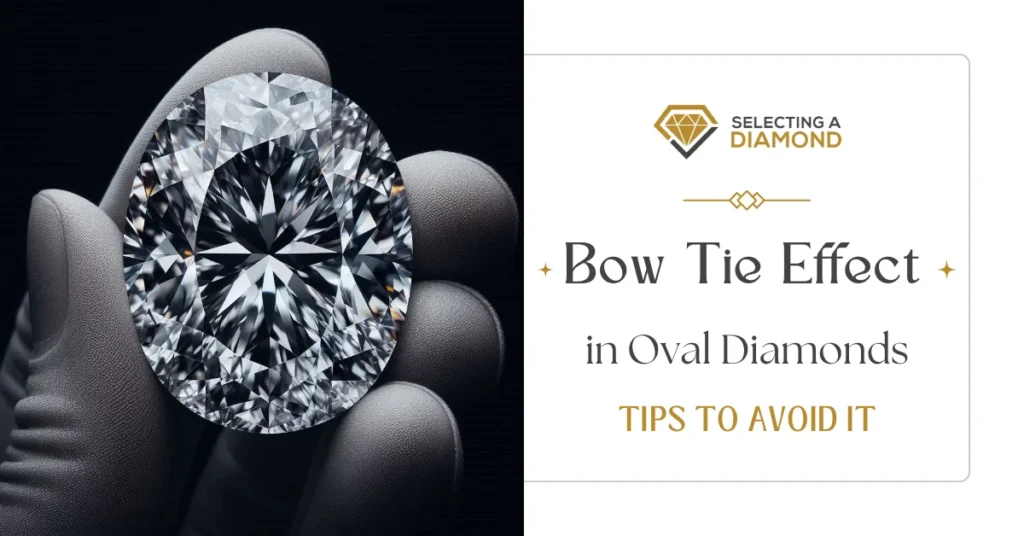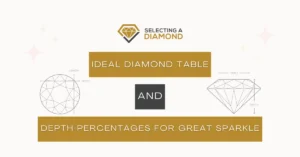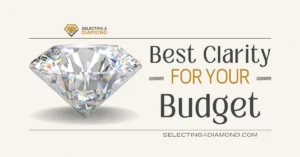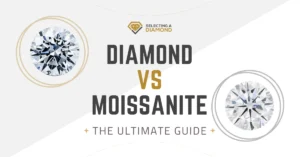In the world of diamonds, the bow tie effect is a bit of a double-edged sword.
It’s this intriguing shadow that stretches across the stone, reminiscent of a stylish bow tie.
While it does add a unique flair, it’s generally not the most desired trait, as it can overshadow the diamond’s sparkle and brilliance, which is why it’s often less preferred.
But not all bow ties are created equal, it’s safe to say that most oval shape diamonds have some degree of bow tie, but that doesn’t mean that all oval shape diamonds are bad!
Some bow ties are quite subtle and barely noticeable, and some are very critical and must be noted if present. Let’s dive deeper and figure out what makes this feature a hit or a miss in the sparkling world of oval diamonds.
Bow Tie in Oval Shape Diamonds
Picture this: a little bow tie sitting right at the heart of your diamond. Sounds fancy, right?
But here’s the twist – while it can be a charming mark of character in your oval gem, a too-dark bow tie might just steal the spotlight from the diamond’s natural sparkle.
To make it clearer, the bow tie’s visibility can be quite the chameleon, changing its look under different lights and angles, and even when the diamond is set in a ring.
It’s not a flaw, but rather a unique trait of these elongated beauties.
These 3 images are for 3 different diamonds on James Allen, with different degrees of how visible the bow tie in each of them.
To inspect these diamonds, here is the first one to the left, with minimal to no bow tie effect, the middle has a bow tie that can be easily spotted, and the one to the right has an extreme bow tie!
What Causes Bow Tie in Oval & Elongated Shapes?
The bow tie caused by light blockage due to the unique cut of the diamond. This shadowy effect is particularly noticeable in elongated shapes like ovals (as well as pear & marquise), where the longer facets may struggle to disperse light evenly.
Interestingly, the angle you look at the diamond from can also contribute to this effect, as it can block light from entering the stone at certain angles, enhancing the visibility of the bow tie (i.e. making it darker from your position of view), that’s why it’s critical to inspect diamond from different angle, and preferably in HD 360-degree images we see on James Allen.
Evaluating Bow Tie: Is Bow Tie Listed on Grading Report?
When evaluating the bow tie effect in oval diamonds, it’s essential to remember that this feature isn’t listed on certification reports, which means that when you see a GIA certificate for a diamond, don’t expect to see any mentioning of Bow Tie.
Here is the grading report for the 2nd diamond we saw above (with a clear bow tie):
Therefore, personal inspection is key.
To assess the prominence of the bow tie effect, you need to view the diamond under various lighting conditions, as its visibility can change depending on light type & angle..
Look at the diamond from different angles and distances to see how the bow tie appears.
A well-balanced oval diamond should have a minimal or unseen bow tie effect, such diamonds ensure that the stone’s overall brilliance isn’t compromised.
Tips For Choosing the Right Oval Diamond
When choosing the right oval diamond, consider the following tips to ensure a minimal or aesthetically pleasing bow tie effect:
- Personal Inspection: Since the bow tie effect isn’t listed on certification, inspect the diamond in person. View it under different lighting and from various angles.
- Balance with Other Qualities: Don’t focus solely on the bow tie effect. Consider how it interacts with the diamond’s overall brilliance, cut, color, and clarity.
- Consult with Experts: Seek advice from a professional jeweler or gemologist who can help you assess the bow tie effect in relation to the diamond’s overall appeal.
- Understand Preferences: Determine your tolerance for the bow tie effect. Some may find a slight bow tie charming, while others might prefer it to be nearly invisible.
Choosing the right oval diamond involves balancing the bow tie effect with other qualities to find a stone that meets your personal taste and standards.
Conclusion
In conclusion, the bow tie effect in oval diamonds is a unique characteristic influenced by the stone’s cut and how it interacts with light.
When selecting an oval diamond, balance the bow tie effect with other qualities like cut, color, and clarity.
Remember, the visibility and appeal of the bow tie effect can vary greatly, so choose based on your personal preference and tolerance for this feature.
With careful consideration, you can find an oval diamond that beautifully aligns with your tastes and standards.
Still not sure where to buy your diamond?
We always recommend shopping diamonds online and created a Full guide to shop diamonds like a Pro.
Among online retailers, here are our favorite stores click their logo to visit store
-
James Allen:
Our favorite online store, best diamond imaging technology available today, comes with the largest collection with more than half a million loose diamonds.
-
Blue Nile:
Widest collection of loose diamonds of all sizes, great imaging technology for most of their inventory (hundreds of thousands of diamonds), great customer support.
-
Whiteflash:
Home Of A CUT ABOVE® Super Ideal Diamonds, they stand out from the crowd by offering premium diamonds cuts, tailored to those who love the details, at great prices too.












